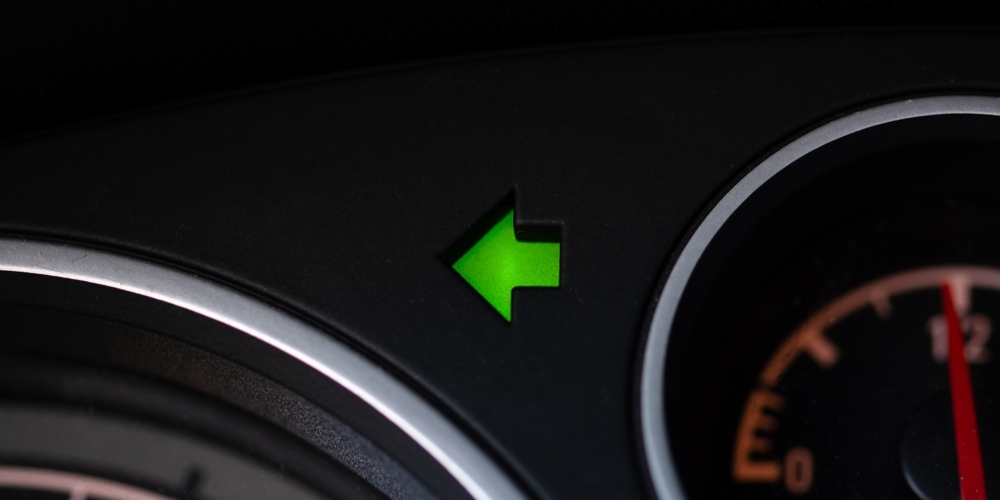
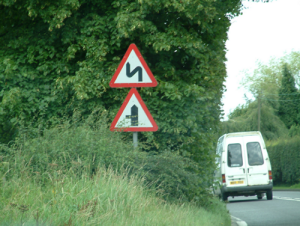
This lesson covers left turns from main roads into side roads, gateways, or other entrances. It builds on the stuff that you have learned about the hazard routine.
You'll probably have already made several left turns during your lessons but might not yet be using a full hazard routine or taking full responsibility without help from your instructor.
The aim of this lesson is to make sure that you gain/consolidate the skill and knowledge required to take full responsibility and make left turns unassisted before moving on to left turns on busier roads.
It's easy to fall into the trap of thinking that left turns are easy - that's because they are!
But as with all aspects of safe driving, there are specific things to look out for and to be aware of.
By the end of the lesson, you should be able to safely apply your hazard routine turn left into a side road.
This video is from the Driving Test Success practical app. For more left-turn videos and videos lessons for lots of other subjects, visit Driving Test Success. (Google Play | App Store - appstore practical videos available as an in app purchase in the 4 in 1 kit)
As shown in the video above, your driving test will include several left turns. These might range from simple left turns in or out of the test-centre car park to left turns at busy traffic light-controlled junctions.
Regardless of the type of left turn, your examiner will look for the same things as any other junction, a routine approach, good observation and good decision-making.
If the examiner does not give you a route direction and you are not in the independent driving phase of the test, you may be missing a road sign telling you to 'turn left only' – be on the lookout for signs and road markings all of the time!
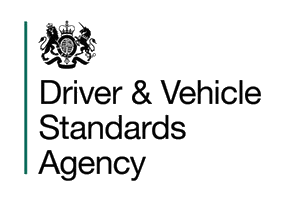
Things to consider:
Use of the hazard routine
Effective observation
Compliance with signs and road markings
Correct positioning before and after the junction
Dealing with other road users safely
As with every other aspect of driving, you will use a routine approach (MSM Routine) when you make left turns.
As a reminder the routine is:
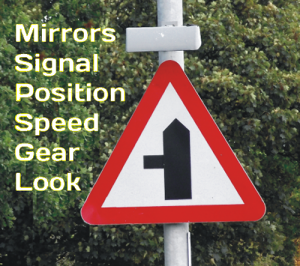
Mirrors
Consider a signal
Check or change your position
Adjust your speed
Manual car: Select the best gear for the job and
Finally double-check to make sure it's safe before deciding to turn
Start your hazard routine early as you approach the turn.
 The first thing to do is check your mirrors.
The first thing to do is check your mirrors.
You can use all your mirrors. However, the most useful here will typically be the interior mirror and the left door mirror (in that order).
Your interior mirror will show you what is happening well behind. The left door mirror will tell you whether there is any immediate problem closer behind and to the left.
For example, if you are going downhill in a built-up area, a cyclist could think of passing you on the left.
Generally speaking, as explained earlier in the course, mirrors are best used in pairs. Interior and left mirrors are usually best for left turns, but there may be exceptions, so always be flexible.
Your mirrors help you gain helpful information about what's happening behind you. This means that sometimes you might find that your right door mirror gives you the information you need, for example, on a bend or because of obstructions behind.
Remember (from your hazard routine lesson) that it's essential to check your mirrors before signalling to find out who you are signalling for and whether it is safe to turn.
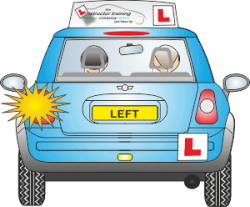 When checking your mirrors, you must bear in mind how tight the turn is.
When checking your mirrors, you must bear in mind how tight the turn is.
The tighter the turn, the slower your speed will need to be. On very tight turns, you will need to give drivers behind extra time to react by signalling and reducing speed early.
Your signal should be given early, but it must not be misleading.
Be careful with your signal timing if there is another road on the left before the one you intend to turn into. In this situation, the following driver or another road user ahead might be confused into thinking that you are taking the first road.
Sometimes in these situations, it's helpful to signal early, then switch off your signal, switching it on again as you pass the 'first road.
For most left turns, you will position by maintaining your normal safety-line driving position - about one metre from the kerb (using a left-turn lane if this is provided).
The only exception to the 'normal' safety-line positioning would be if you were turning into a very tight road or gateway. In this type of situation, you may need to 'swing out'; in these circumstances, you need to take extra care, making sure that all other road users are fully aware of your intentions and that you are aware of theirs.
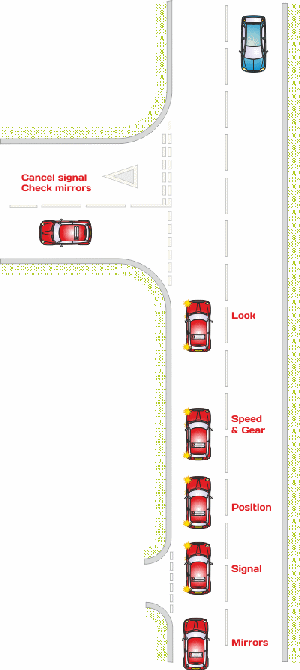 Situations where you need to swing out, are pretty rare, and your driving instructor will ensure that you have had lots of practise with 'easy' left turns before taking you to any 'tricky' ones!
Situations where you need to swing out, are pretty rare, and your driving instructor will ensure that you have had lots of practise with 'easy' left turns before taking you to any 'tricky' ones!
Having sorted out your position, you can now adjust your speed.
In a manual car, you will often use second gear for left turns like the one shown in the diagram. Your speed must be eight mph or less before changing to the gear for the turn - you must be positive with your braking. A good trick is to make the car feel like it's going too slow on the approach and then ease off the brake either slightly or entirely when you change gear.
If your view is restricted or the turn is exceptionally tight, you might need first gear in a manual car. If the junction is 'Y' shaped, third gear might be OK. The important thing is that the gear must give you complete control as you turn and sufficient power to accelerate after turning.
In an automatic, use your footbrake to slow down to a safe speed for the turn before you start to steer.
In an electric car, ease off or release the power to slow down to a safe speed for the turn before you begin to steer. Whether or not you need to brake will depend on the vehicle setup and driving characteristics.
You must go slowly enough to stop if needed, for example, if a pedestrian steps out.
Regardless of the type of car being driven, one of the most common problems with left turns is excessive speed on approach - just a few miles per hour too fast can make a big difference.
Ideally, your speed will be 'spot on'; however, If you must make a mistake - make the mistake of going a bit too slow. That will be easier to fix later!
 Finally, check to ensure it is 100% safe to turn.
Finally, check to ensure it is 100% safe to turn.
Check your left door mirror for cyclists, look ahead for turning vehicles, and look into the new road for parked cars or vehicles approaching on the wrong side of the road. One of the things you will discover about driving is that you have to be a bit of a detective - looking for the clues that will keep you safe from danger!
Usually, when turning left, you can keep moving without stopping. However, you must always be ready to stop and give way if necessary.
Look for pedestrians. You must give way to anyone crossing the road you are turning into. If turning into a garage or driveway, remember that pedestrians always have priority on the footpath.
If you need to stop and give way to another road user, give them plenty of room to manoeuvre; if you are waiting for a pedestrian, don't harass them by revving your engine or sounding the horn.
After turning the corner, make sure your signal is cancelled and recheck your mirrors. The reason for checking mirrors on the new road is that you are now ready to increase your speed (assuming that the road ahead is clear). You must be sure that no one is trying to overtake you.

Click here to complete the quiz for this lesson
(The page will open in a new window/tab)
You will find references for the answers in this lesson.
You can check your answers as you go along, or complete the full quiz before checking.
Leaving the check to the end is a good way to test yourself.
When you check or review your answers you will get a brief explanation of the answer.
Good Luck!

This warning sign alerts you to a junction on the left ahead.
The thickness of the lines shows that you are on the main road but there is no way to know whether the road on the left is controlled by Give Way lines, Stop lines or whether there are no road markings at all... But regardless of the way the road is marked, emerging drivers should give way to you.
'Should' doesn't mean that they always will. They could be lost, distracted, drunk, drugged, tired or impaired in some other way. Their brakes might fail. They could be kids on bikes without a care in the world.
As a minimum, depending on your view, ease of the gas until you are sure it is safe to drive past the side road.
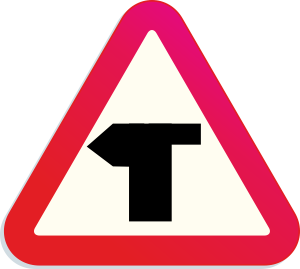
Here the main road turns left, but beware of traffic from the right who may have missed signs or markings.
The same rules apply as for the first sign - you don't know who might be emerging from the side road.
In this situation your speed will be determined, in part, by how tight the bend to the left is.
This is an old version of the warning sign for a side road on the left. The chances are that you will never see this sign as it has been phased out, however, there might still be a few left - and you might see similar signs if you drive abroad.
The same 'rules' apply as for the modern version.

Here you have no choice, you must turn left ahead.
This compulsory sign is used on the approach to one-way systems and other places where drivers have to turn left.
Sometimes the sign might have a white 'text plate' underneath with information about vehicles that are exempt - for example, buses and taxis might be permitted to go straight ahead and 'ignore' the sign.
When you arrive at the turn there will be a sign like the one shown below.

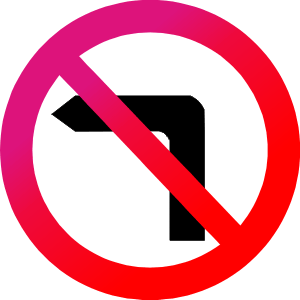
It might seem strange to include this 'no left turn' sign in a lesson that is teaching you to turn left, however, if you are in a strange area and your sat-nav says 'next left' it doesn't mean down this road!
When you see this sign you might expect traffic to be emerging - but not always. The sign could be for a street where vehicles are prohibited.

This is an example of a sign showing a left turn after a double bend. Although the sign tells us that there is a left turn coming up is difficult to tell exactly where the junction is. Any emerging traffic could be hidden from view just around the bend.
As a general rule when there are two signs together the first hazard is shown by the top sign - on this occasion the bends come first. However always be cautious because the traffic engineers sometimes make mistakes when putting up the signs!

If you ever drive in Paris you might come across this sign...
It's directing you to turn left around a roundabout.
We think that you would be better off taking the Métro (the Paris Underground transport system).